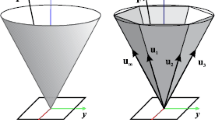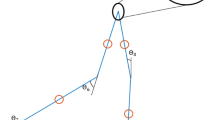Abstract
Instability and risk of fall during standing and walking are common challenges for biped robots. While existing criteria from state-space dynamical systems approach or ground reference points are useful in some applications, complete system models and constraints have not been taken into account for prediction and indication of fall for general legged robots. In this study, a general numerical framework that estimates the balanced and falling states of legged systems is introduced. The overall approach is based on the integration of joint-space and Cartesian-space dynamics of a legged system model. The full-body constrained joint-space dynamics includes the contact forces and moments term due to current foot (or feet) support and another term due to altered contact configuration. According to the refined notions of balanced, falling, and fallen, the system parameters, physical constraints, and initial/final/boundary conditions for balancing are incorporated into constrained nonlinear optimization problems to solve for the velocity extrema (representing the maximum perturbation allowed to maintain balance without changing contacts) in the Cartesian space at each center-of-mass (COM) position within its workspace. The iterative algorithm constructs the stability boundary as a COM state-space partition between balanced and falling states. Inclusion in the resulting six-dimensional manifold is a necessary condition for a state of the given system to be balanced under the given contact configuration, while exclusion is a sufficient condition for falling. The framework is used to analyze the balance stability of example systems with various degrees of complexities. The manifold for a 1-degree-of-freedom (DOF) legged system is consistent with the experimental and simulation results in the existing studies for specific controller designs. The results for a 2-DOF system demonstrate the dependency of the COM state-space partition upon joint-space configuration (elbow-up vs. elbow-down). For both 1- and 2-DOF systems, the results are validated in simulation environments. Finally, the manifold for a biped walking robot is constructed and illustrated against its single-support walking trajectories. The manifold identified by the proposed framework for any given legged system can be evaluated beforehand as a system property and serves as a map for either a specified state or a specific controller’s performance.
















Similar content being viewed by others
References
Abdel-Malek, K., Yeh, H.J.: Analytical boundary of the workspace for general 3-DOF mechanisms. Int. J. Robot. Res. 16(2), 198–213 (1997)
Aftab, Z., Robert, T., Wieber, P.-B.: Balance recovery prediction with multiple strategies for standing humans. PLoS One 11(3), e0151166 (2016)
Alba, M., Prada, J.C.G., Meneses, J., Rubio, H.: Center of percussion and gait design of biped robots. Mech. Mach. Theory 45(11), 1681–1693 (2010)
Aubin, J.P.: Viability Theory. Springer, Berlin (2009)
Cotton, S., Fraisse, P., Murray, A.P.: On the manipulability of the center of mass of humanoid robots: application to design. In: ASME 2010 International Design Engineering Technical Conferences and Computers and Information in Engineering Conferences, pp. 1259–1267 (2010)
Cyberbotics Ltd., Copyright (2016) https://www.cyberbotics.com/reference/. release 8.4.0
Dingwell, J.B., Cusumano, J.P., Sternad, D., Cavanagh, P.R.: Slower speeds in patients with diabetic neuropathy lead to improved local dynamic stability of continuous overground walking. J. Biomech. 33(10), 1269–1277 (2000)
Firmani, F., Park, E.J.: Theoretical analysis of the states of balance in bipedal walking. J. Biomech. Eng. 135(4), 041003/1–041003/13 (2013)
Ghiasi, A.R., Alizadeh, G., Mirzaei, M.: Simultaneous design of optimal gait pattern and controller for a bipedal robot. Multibody Syst. Dyn. 23(4), 401–429 (2010)
Gill, P.E., Murray, W., Saunders, M.A.: SNOPT: an SQP algorithm for large-scale constrained optimization. SIAM Rev. 47(1), 99–131 (2005)
Goswami, A.: Postural stability of biped robots and the foot-rotation indicator (FRI) point. Int. J. Robot. Res. 18(6), 523–533 (1999)
Goswami, A., Kallem, V.: Rate of change of angular momentum and balance maintenance of biped robots. In: 2004 IEEE International Conference on Robotics and Automation. Proceedings. ICRA’04. 2004 , vol. 4, pp. 3785–3790 (2004)
Gu, Y., Lee, C.G., Yao, B.: Feasible center of mass dynamic manipulability of humanoid robots. In: 2015 IEEE International Conference on Robotics and Automation (ICRA), pp. 5082-5087, May (2015)
Ha, I., Tamura, Y., Asama, H.: Gait pattern generation and stabilization for humanoid robot based on coupled oscillators. IEEE/RSJ International Conference on Intelligent Robots and Systems (IROS), pp. 3207-3212, September (2011)
Ha, I., Tamura, Y., Asama, H.: Development of open platform humanoid robot DARwIn-OP. Adv. Robot. 27(3), 223–232 (2013)
Herr, H., Popovic, M.: Angular momentum in human walking. J. Exp. Biol. 211(4), 467–481 (2008)
Hobbelen, D.G., Wisse, M.: A disturbance rejection measure for limit cycle walkers: the gait sensitivity norm. IEEE Trans. Robot. 23(6), 1213–1224 (2007)
http://support.robotis.com/en/product/dynamixel/mx_series/mx-28.htm
Hurmuzlu, Y., Basdogan, C.: On the measurement of dynamic stability of human locomotion. J. Biomech. Eng. 116(1), 30–36 (1994)
Kalyanakrishnan, S., Goswami, A.: Predicting falls of a humanoid robot through machine learning. In: Twenty-Second IAAI Conference on Artificial Intelligence, Atlanta, GA, USA (2010)
Kalyanakrishnan, S., Goswami, A.: Learning to predict humanoid fall. Int. J. Humanoid Robot. 8(2), 245–273 (2011)
Kim, J.H., Xiang, Y., Yang, J., Arora, J.S., Abdel-Malek, K.: Dynamic motion planning of overarm throw for a biped human multibody system. Multibody Syts. Dyn. 24(1), 1–24 (2010)
Kim, J.H.: Optimization of throwing motion planning for whole-body humanoid mechanism: sidearm and maximum distance. Mech. Mach. Theory 46(4), 438–453 (2011)
Kim, J.H., Abdel-Malek, K., Xiang, Y., Yang, J.J., Arora, J.S.: Concurrent motion planning and reaction load distribution for redundant dynamic systems under external holonomic constraints. Int. J. Numer. Meth. Eng. 88(1), 47–65 (2011)
Kim, J.H., Joo, C.B.: Numerical construction of balanced state manifold for single-support legged mechanism in sagittal plane. Multibody Syst. Dyn. 31(3), 257–281 (2014)
Koolen, T., De Boer, T., Rebula, J., Goswami, A., Pratt, J.: Capturability-based analysis and control of legged locomotion, Part 1: theory and application to three simple gait models. Int. J. Robot. Res. 31(9), 1094–1113 (2012)
Kuffner Jr., J.J., Kagami, S., Nishiwaki, K., Inaba, M., Inoue, H.: Dynamically-stable motion planning for humanoid robots. Auton. Robots 12(1), 105–118 (2002)
Lee, S.H., Goswami, A.: Reaction mass pendulum (RMP): an explicit model for centroidal angular momentum of humanoid robots. In: Proceedings 2007 IEEE International Conference on Robotics and Automation, pp. 4667-4672, Roma, Italy, April 10–14 (2007)
Lee, S.H., Goswami, A.: Ground reaction force control at each foot: a momentum-based humanoid balance controller for non-level and non-stationary ground. In: 2010 IEEE/RSJ International Conference on Intelligent Robots and Systems (IROS), pp. 3157-3162, October (2010)
Mummolo, C., Kim, J.H.: Passive and dynamic gait measures for biped mechanism: formulation and simulation analysis. Robotica 31(4), 555–572 (2013)
Mummolo, C., Mangialardi, L., Kim, J.H.: Quantifying dynamic characteristics of human walking for comprehensive gait cycle. J. Biomech. Eng. Trans. ASME 135(9), 091006/1–091006/10 (2013)
Mummolo, C., Mangialardi, L., Kim, J.H.: Contact status optimization of multibody dynamic systems using dual variable transformation. In: ASME International Design Engineering Technical Conferences and Computers and Information in Engineering Conference, pp. V006T10A069–V006T10A069, Buffalo, New York, August (2014)
Mummolo, C., Mangialardi, L., Kim, J.H.: Concurrent contact planning and trajectory optimization in one step walking motion. In: ASME International Design Engineering Technical Conferences and Computers and Information in Engineering Conference, pp. V008T13A018–V008T13A018, Boston, Massachusetts, August (2015a)
Mummolo, C., Mangialardi, L., Kim, J.H.: Identification of balanced states for multi-segmental legged robots using reduced-order model. In: 2015 IEEE-RAS 15th International Conference on Humanoid Robots (Humanoids), pp. 914–919 (2015b)
Mummolo, C., Park, S., Mangialardi, L., Kim, J.H.: Computational evaluation of load carriage effects on gait balance stability. Comput. Methods Biomech. Biomed. Eng. 19(11), 1127–1136 (2016)
Obayashi, I., Aoi, S., Tsuchiya, K., Kokubu, H.: Formation mechanism of a basin of attraction for passive dynamic walking induced by intrinsic hyperbolicity. Proc. R. Soc. A 472(2190), 20160028 (2016)
Orin, D.E., Goswami, A., Lee, S.H.: Centroidal dynamics of a humanoid robot. Auton. Robots 35(2–3), 161–176 (2013)
Pai, Y., Patton, J.: Center of mass velocity-position predictions for balance control. J. Biomech. 30(4), 347–354 (1997)
Patton, J.L., Pai, Y.-C., Lee, W.A.: Evaluation of a model that determines the stability limits of dynamic balance. Gait Posture 9(1), 38–49 (1999)
Park, S., Horak, F.B., Kuo, A.D.: Postural feedback responses scale with biomechanical constraints in human standing. Exp. Brain Res. 154(4), 417–427 (2004)
Perry, J., Burnfield, J.M.: Gait Analysis: Normal and Pathological Function. Slack Inc., Thorofare (1992)
Popovic, M.B., Goswami, A., Herr, H.: Ground reference points in legged locomotion: definitions, biological trajectories and control implications. Int. J. Robot. Res. 24(12), 1013–1032 (2005)
Pratt, J.E., Tedrake, R.: Velocity-based stability margins for fast bipedal walking. In: Fast Motions in Biomechanics and Robotics Lecture Notes in Control and Information Sciences, vol. 340, pp. 299–324. Springer, Berlin (2006)
Pratt, J., Koolen, T., De Boer, T., Rebula, J., Cotton, S., Carff, J., Johnson, M., Neuhaus, P.: Capturability-based analysis and control of legged locomotion, Part 2: application to M2V2, a lower body humanoid. Int. J. Robot. Res. 31(10), 1117–1133 (2012)
Ross, S.D., Tanaka, M.L., Senatore, C.: Detecting dynamical boundaries from kinematic data in biomechanics, Chaos: an interdisciplinary. J. Nonlinear Sci. 20(1), 017507 (2010)
Sardain, P., Bessonnet, G.: Forces acting on a biped robot: center of pressure-zero moment point. IEEE Trans. Syst. Man Cybern. Part A 34(5), 630–637 (2004)
Siciliano, B., Sciavicco, L., Villani, L., Oriolo, G.: Robotics: Modelling, Planning and Control. Springer, Berlin (2010)
Stephens, B.: Humanoid push recovery. In: 7th IEEE-RAS International Conference on Humanoid Robots, pp. 589-595, Pittsburgh, PA, USA, November (2007a)
Stephens, B.: Integral control of humanoid balance. In: 2007 IEEE/RSJ International Conference on Intelligent Robots and Systems, pp. 4020-4027, October (2007b)
Stephens, B., Atkeson, C.: Modeling and control of periodic humanoid balance using the linear biped model. In: 9th IEEE-RAS International Conference on Humanoid Robots, pp. 379-384, Paris, December (2009)
Vukobratović, M., Potkonjak, V., Babković, K., Borovac, B.: Simulation model of general human and humanoid motion. Multibody Syst. Dyn. 17(1), 71–96 (2007)
Vukobratović, M., Borovac, B.: Zero-moment point—thirty five years of its life. Int. J. Humanoid Robot. 1(1), 157–173 (2004)
Wen, J.Y., Wilfinger, L.S.: Kinematic manipulability of general constrained rigid multibody systems. IEEE Trans. Robot. Autom. 15(3), 558–567 (1999)
Wieber, P.B.: On the stability of walking systems. In: Proceedings of the International Workshop on Humanoid and Human Friendly Robotics (2002)
Wieber, P.B.: Viability and predictive control for safe locomotion. In: 2008 IEEE/RSJ International Conference on Intelligent Robots and Systems, pp. 1103-1108, Nice, France, September (2008)
Yang, C., Wu, Q.: Effects of constraints on bipedal balance control. In: American Control Conference. IEEE, Minneapolis, MN, USA, June (2006)
Yang, C., Wu, Q.: Effects of gravity and friction constraints on bipedal balance control. In: Proceedings of 2005 IEEE Conference on Control Applications, 2005. CCA 2005, pp. 1093-1098, Toronto, ON, Canada (2005)
Yang, C., Wu, Q., Joyce, G.: Effects of constraints on bipedal balance control during standing. Int. J. Humanoid Robot. 4(4), 753–775 (2007)
Yoshikawa, T.: Dynamic manipulability of robot manipulators. In: 1985 IEEE International Conference on Robotics and Automation. Proceedings, vol. 2, pp. 1033–1038, March (1985)
Zaytsev, P., Hasaneini, S.J., Ruina, A.: Two steps is enough: no need to plan far ahead for walking balance. In: 2015 IEEE International Conference on Robotics and Automation (ICRA), pp. 6295–6300, May (2015)
Zielinska, T., Chew, C.-M., Kryczka, P., Jargilo, T.: Robot gait synthesis using the scheme of human motions skills development. Mech. Mach. Theory 44, 541–558 (2009)
Acknowledgements
The authors would like to thank Wenjie Chen, Francesco Cursi, and William Peng for their help in the modeling and walking simulation of DARwIn-OP and valuable discussion. A preliminary portion of this material was presented at the 2016 ASME IDETC/CIE 40th Mechanisms and Robotics Conference (Charlotte, NC, USA). Funding was provided by U.S. National Science Foundation (NSF) Division of Civil, Mechanical and Manufacturing Innovation (Grant No. CMMI-1436636) and Division of Information and Intelligent Systems (Grant No. IIS-1427193).
Author information
Authors and Affiliations
Corresponding author
Additional information
Communicated by Maurizio Porfiri.
Rights and permissions
About this article
Cite this article
Mummolo, C., Mangialardi, L. & Kim, J.H. Numerical Estimation of Balanced and Falling States for Constrained Legged Systems. J Nonlinear Sci 27, 1291–1323 (2017). https://doi.org/10.1007/s00332-016-9353-2
Received:
Accepted:
Published:
Issue Date:
DOI: https://doi.org/10.1007/s00332-016-9353-2
Keywords
- Balanced state
- Constrained dynamics
- Contact configuration
- Falling state
- Legged system
- Nonlinear optimization
- Stability
- State space




